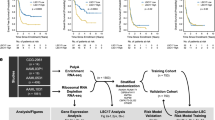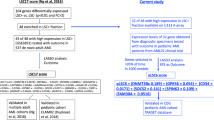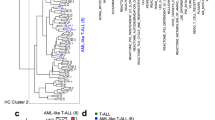Abstract
Acute myeloid leukemia (AML) blasts are immature committed myeloid cells unable to spontaneously undergo terminal maturation, and characterized by heterogeneous sensitivity to natural differentiation inducers. Here, we show a molecular signature predicting the resistance or sensitivity of six myeloid cell lines to differentiation induced in vitro with retinoic acid or vitamin D. The identified signature was further validated by TaqMan assay for the prediction of response to an in vitro differentiation assay performed on 28 freshly isolated AML blast populations. The TaqMan assay successfully predicts the in vitro resistance or responsiveness of AML blasts to differentiation inducers. Furthermore, performing a meta-analysis of publicly available microarray data sets, we also show the accuracy of our prediction on known phenotypes and suggest that our signature could become useful for the identification of patients eligible for new therapeutic strategies.
This is a preview of subscription content, access via your institution
Access options
Subscribe to this journal
Receive 12 print issues and online access
$259.00 per year
only $21.58 per issue
Buy this article
- Purchase on Springer Link
- Instant access to full article PDF
Prices may be subject to local taxes which are calculated during checkout



Similar content being viewed by others
References
Tallman MS . Acute promyelocytic leukemia as a paradigm for targeted therapy. Semin Hematol 2004; 41 (Suppl 4): 27–32.
Manfredini R, Trevisan F, Grande A, Tagliafico E, Montanari M, Lemoli R et al. Induction of a functional vitamin D receptor in all-trans-retinoic acid-induced monocytic differentiation of M2-type leukemic blast cells. Cancer Res 1999; 59: 3803–3811.
Kumagai T, Shih LY, Hughes SV, Desmond JC, O’Kelly J, Hewison M et al. 19-Nor-1,25(OH)2D2 (a novel, noncalcemic vitamin D analogue), combined with arsenic trioxide, has potent antitumor activity against myeloid leukemia. Cancer Res 2005; 65: 2488–2497.
Waxman S . Differentiation therapy in acute myelogenous leukemia (non-APL). Leukemia 2000; 14: 491–496.
Bruserud O, Gjertsen BT . New strategies for the treatment of acute myelogenous leukemia: differentiation induction – present use and future possibilities. Stem Cells 2000; 18: 157–165.
Golub TR, Slonim DK, Tamayo P, Huard C, Gaasenbeek M, Mesirov JP et al. Molecular classification of cancer: class discovery and class prediction by gene expression monitoring. Science 1999; 286: 531–537.
Schoch C, Kohlmann A, Schnittger S, Brors B, Dugas M, Mergenthaler S et al. Acute myeloid leukemias with reciprocal rearrangements can be distinguished by specific gene expression profiles. Proc Natl Acad Sci USA 2002; 99: 10008–10013.
Kohlmann A, Schoch C, Schnittger S, Dugas M, Hiddemann W, Kern W et al. Molecular characterization of acute leukemias by use of microarray technology. Genes Chromosomes Cancer 2003; 37: 396–405.
Debernardi S, Lillington DM, Chaplin T, Tomlinson S, Amess J, Rohatiner A et al. Genome-wide analysis of acute myeloid leukemia with normal karyotype reveals a unique pattern of homeobox gene expression distinct from those with translocation-mediated fusion events. Genes Chromosomes Cancer 2003; 37: 149–158.
Valk PJ, Verhaak RG, Beijen MA, Erpelinck CA, van Waalwijk van Doorn-Khosrovani B, Boer JM et al. Prognostically useful gene-expression profiles in acute myeloid leukemia. N Engl J Med 2004; 350: 1617–1628.
Bullinger L, Dohner K, Bair E, Frohling S, Schlenk RF, Tibshirani R et al. Use of gene-expression profiling to identify prognostic subclasses in adult acute myeloid leukemia. N Engl J Med 2004; 350: 1605–1616.
Haferlach T, Kern W, Schoch C, Schnittger S, Sauerland MC, Heinecke A et al. A new prognostic score for patients with acute myeloid leukemia based on cytogenetics and early blast clearance in trials of the German AML Cooperative Group. Haematologica 2004; 89: 408–418.
Kohlmann A, Schoch C, Dugas M, Schnittger S, Hiddemann W, Kern W et al. New insights into MLL gene rearranged acute leukemias using gene expression profiling: shared pathways, lineage commitment, and partner genes. Leukemia 2005; 19: 953–964.
Kohlmann A, Schoch C, Dugas M, Rauhut S, Weninger F, Schnittger S et al. Pattern robustness of diagnostic gene expression signatures in leukemia. Genes Chromosomes Cancer 2005; 42: 299–307.
Haferlach T, Kohlmann A, Schnittger S, Dugas M, Hiddemann W, Kern W et al. Global approach to the diagnosis of leukemia using gene expression profiling. Blood 2005; 106: 1189–1198.
Heuser M, Wingen LU, Steinemann D, Cario G, von Neuhoff N, Tauscher M et al. Gene-expression profiles and their association with drug resistance in adult acute myeloid leukemia. Haematologica 2005; 90: 1484–1492.
Koeffler HP, Golde DW . Acute myelogenous leukemia: a human cell line responsive to colony-stimulating activity. Science 1978; 200: 1153–1154.
Furley AJ, Reeves BR, Mizutani S, Altass LJ, Watt SM, Jacob MC et al. Divergent molecular phenotypes of KG1 and KG1a myeloid cell lines. Blood 1986; 68: 1101–1107.
Asou H, Tashiro S, Hamamoto K, Otsuji A, Kita K, Kamada N . Establishment of a human acute myeloid leukemia cell line (Kasumi-1) with 8;21 chromosome translocation. Blood 1991; 77: 2031–2036.
Tsuchiya S, Yamabe M, Yamaguchi Y, Kobayashi Y, Konno T, Tada K . Establishment and characterization of a human acute monocytic leukemia cell line (THP-1). Int J Cancer 1980; 26: 171–176.
Lanotte M, Martin Thouvenin V, Najman S, Balerini P, Valensi F, Berger R . NB4, a maturation inducible cell line with t(15;17) marker isolated from a human acute promyelocytic leukemia (M3). Blood 1991; 77: 1080–1086.
James SY, Williams MA, Newland AC, Colston KW . Leukemia cell differentiation: cellular and molecular interactions of retinoids and vitamin D. Gen Pharmacol 1999; 32: 143–154.
Lea MA . Action of exogenous differentiating agents on gene expression in cancer cells. Crit Rev Oncol Hematol 1992; 13: 189–214.
Tagliafico E, Siena M, Zanocco-Marani T, Manfredini R, Tenedini E, Montanari M et al. Requirement of the coiled-coil domains of p92(c-Fes) for nuclear localization in myeloid cells upon induction of differentiation. Oncogene 2003; 22: 1712–1723.
Grande A, Montanari M, Tagliafico E, Manfredini R, Marani TZ, Siena M et al. Physiological levels of 1alpha, 25 dihydroxyvitamin D3 induce the monocytic commitment of CD34+ hematopoietic progenitors. J Leukocyte Biol 2002; 71: 641–651.
Manfredini R, Zini R, Salati S, Siena M, Tenedini E, Tagliafico E et al. The kinetic status of hematopoietic stem cell subpopulations underlies a differential expression of genes involved in self-renewal, commitment, and engraftment. Stem Cells 2005; 23: 496–506.
Montanari M, Gemelli C, Tenedini E, Zanocco MT, Vignudelli T, Siena M et al. Correlation between differentiation plasticity and mRNA expression profiling of CD34+ derived. Cell Death Differ 2005; 12: 1588–1600.
Tagliafico E, Tenedini E, Bergamaschi A, Manfredini R, Percudani R, Siena M et al. Gene expression profile of Vitamin D3 treated HL60 cells shows an incomplete molecular phenotypic conversion to monocytes. Cell Death Differ 2002; 9: 1185–1195.
Ferrari S, Donelli A, Manfredini R, Sarti M, Roncaglia R, Tagliafico E et al. Differential effects of c-myb and c-fes antisense oligodeoxynucleotides on granulocytic differentiation of human myeloid leukemia HL60 cells. Cell Growth Differ 1990; 1: 543–548.
Grande A, Montanari M, Manfredini R, Tagliafico E, Zanocco-Marani T, Trevisan F et al. A functionally active RARalpha nuclear receptor is expressed in retinoic acid non responsive early myeloblastic cell lines. Cell Death Differ 2001; 8: 70–82.
Grande A, Manfredini R, Tagliafico E, Balestri R, Pizzanelli M, Papa S et al. All trans retinoic acid induces simultaneously granulocytic differentiation and expression of inflammatory cytokines in HL 60 cells. Exp Hematol 1995; 23: 117–125.
Liu WM, Mei R, Di X, Ryder TB, Hubbell E, Dee S et al. Analysis of high density expression microarrays with signed-rank call algorithms. Bioinformatics 2002; 18: 1593–1599.
Irizarry RA, Hobbs B, Collin F, Beazer-Barclay YD, Antonellis KJ, Scherf U et al. Exploration, normalization, and summaries of high density oligonucleotide array probe level data. Biostatistics 2003; 4: 249–264.
Li C, Wong WH . Model-based analysis of oligonucleotide arrays: expression index computation and outlier detection. Proc Natl Acad Sci USA 2001; 98: 31–36.
Li C, Hung WW . Model-based analysis of oligonucleotide arrays: model validation, design issues and standard error application. Genome Biol 2001; 2: 1–11.
Manfredini R, Grande A, Tagliafico E, Barbieri D, Zucchini P, Citro G et al. Inhibition of c-fes expression by an antisense oligomer causes apoptosis of HL60 cells induced to granulocytic differentiation. J Exp Med 1993; 178: 381–389.
Tsiftsoglou AS, Pappas IS, Vizirianakis IS . Mechanisms involved in the induced differentiation of leukemia cells. Pharmacol Ther 2003; 100: 257–290.
Waxman S . Differentiation therapy in acute myelogenous leukemia (non-APL). Leukemia 2000; 14: 491–496.
Olsson I, Bergh G, Ehinger M, Gullberg U . Cell differentiation in acute myeloid leukemia. Eur J Haematol 1996; 57: 1–16.
Calvo KR, Knoepfler PS, Sykes DB, Pasillas MP, Kamps MP . Meis1a suppresses differentiation by G-CSF and promotes proliferation by SCF: potential mechanisms of cooperativity with Hoxa9 in myeloid leukemia. Proc Natl Acad Sci USA 2001; 98: 13120–13125.
Thorsteinsdottir U, Kroon E, Jerome L, Blasi F, Sauvageau G . Defining roles for HOX and MEIS1 genes in induction of acute myeloid leukemia. Mol Cell Biol 2001; 21: 224–234.
Lee BC, Cheng T, Adams GB, Attar EC, Miura N, Lee SB et al. P2Y-like receptor, GPR105 (P2Y14), identifies and mediates chemotaxis of bone-marrow hematopoietic stem cells. Genes Dev 2003; 17: 1592–1604.
Donato JL, Ko J, Kutok JL, Cheng T, Shirakawa T, Mao XQ et al. Human HTm4 is a hematopoietic cell cycle regulator. J Clin Invest 2002; 109: 51–58.
Lossos IS, Czerwinski DK, Alizadeh AA, Wechser MA, Tibshirani R, Botstein D et al. Prediction of survival in diffuse large-B-cell lymphoma based on the expression of six genes. N Engl J Med 2004; 350: 1828–1837.
Li W, Kessler P, Yeger H, Alami J, Reeve AE, Heathcott R et al. A gene expression signature for relapse of primary wilms tumors. Cancer Res 2005; 65: 2592–2601.
Acknowledgements
This work was supported by AIL (Italian Association against Leukemia), AIRC (Italian Association for Cancer Research), CIB (Italian Consortium for Biotechnology) and MIUR. Tenedini Gemelli and Bianchi have fellowships of PRITT (Integrated Regional Programme for Innovation and Technology Transfer/ERGENTECH).
Author information
Authors and Affiliations
Corresponding author
Additional information
Supplementary Information accompanies the paper on the Leukemia website (http://www.nature.com/leu)
Rights and permissions
About this article
Cite this article
Tagliafico, E., Tenedini, E., Manfredini, R. et al. Identification of a molecular signature predictive of sensitivity to differentiation induction in acute myeloid leukemia. Leukemia 20, 1751–1758 (2006). https://doi.org/10.1038/sj.leu.2404358
Received:
Revised:
Accepted:
Published:
Issue Date:
DOI: https://doi.org/10.1038/sj.leu.2404358
Keywords
This article is cited by
-
Induced differentiation of acute myeloid leukemia cells by activation of retinoid X and liver X receptors
Leukemia (2014)
-
Platelet-derived growth factor alpha mediates the proliferation of peripheral T-cell lymphoma cells via an autocrine regulatory pathway
Leukemia (2014)
-
The microRNA-26a target E2F7 sustains cell proliferation and inhibits monocytic differentiation of acute myeloid leukemia cells
Cell Death & Disease (2012)
-
Gene expression profiling in MDS and AML: potential and future avenues
Leukemia (2011)
-
Contributions of the Raf/MEK/ERK, PI3K/PTEN/Akt/mTOR and Jak/STAT pathways to leukemia
Leukemia (2008)



